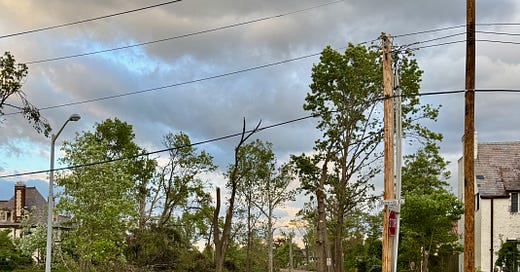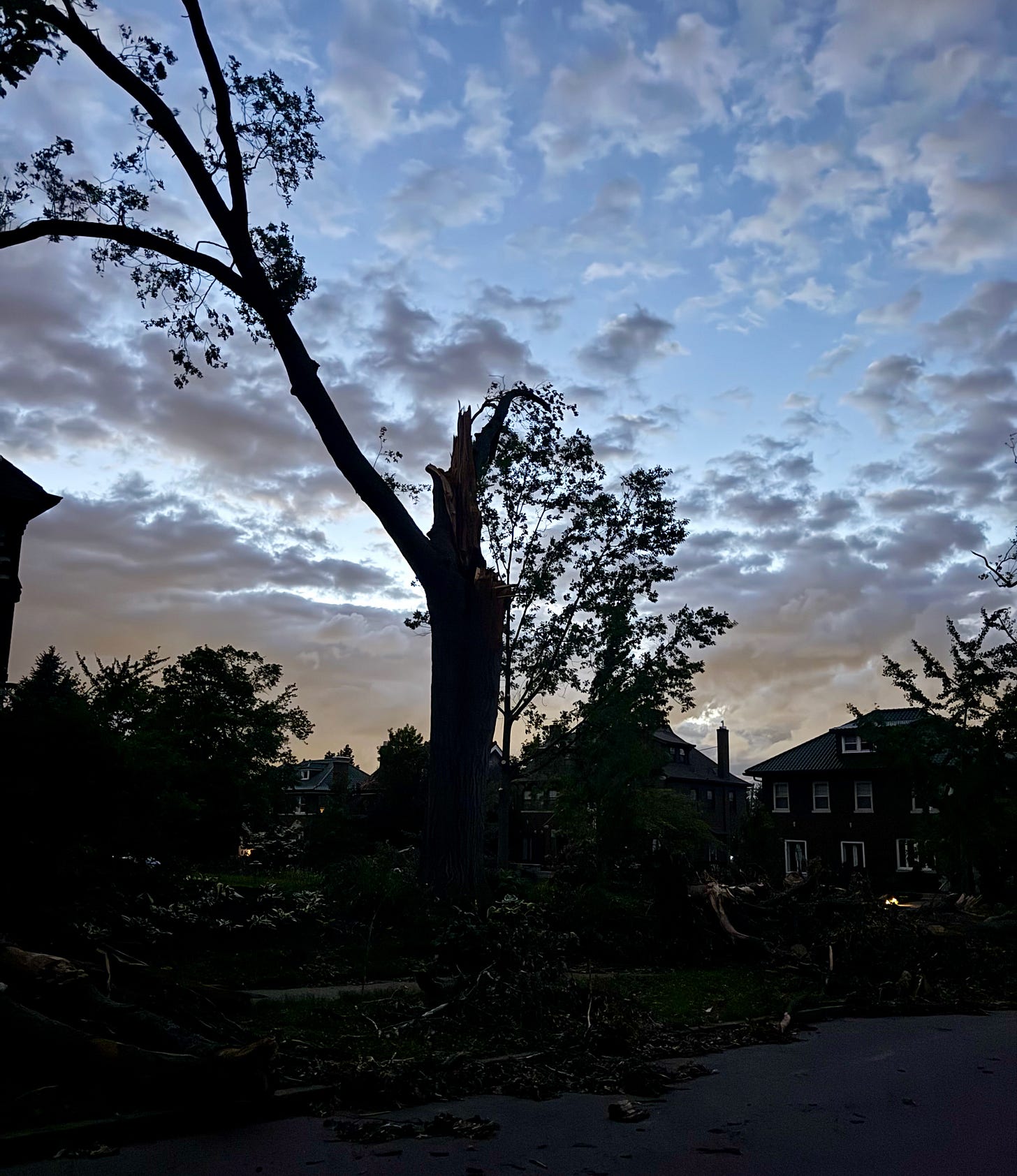on the other side of the fence
A tornado hit St. Louis last week. You know that already. What you might not know is what it's been like here for the past week, alternately normal and horrifying.
Lately: I moved to St. Louis, hence the pause in this newsletter. There was a tornado, hence the subject of this newsletter. That’s been the defining event of my first two weeks back in the Midwest, and it’ll probably define the next few months. So it only felt natural to table some of the other stuff I wanted to write and share a few words about what it’s been like here the past week, at least from my (very, very fortunate) perspective.
on the other side of the fence
When the storm cleared, I grilled a steak. They always clear quickly here, the bruising, green-skied springtime squalls I’ve been riding out since I was a kid. Hell is empty and all the devils are here — but they tend to leave in a hurry, and the bluebirds never stop chirping for long. My husband, a Midwesterner for six days at that point, couldn’t believe it. “It’s just going to be sunny now? Already?”
Ten minutes earlier, I’d knocked on the door to his office, with its three walls of tall windows. The tornado siren, the first he’d ever heard, was wailing, so I suggested we head downstairs. It was twilight in the midafternoon, dark skies to the north, a soupy kaleidoscope of yellowish-green to the south, and it had just started to rain when the wind — the edge of the tornado, I now know — stampeded down our street. Trees did side-bends and sticks swirled in the air. We heard something crack — far off or close by, we weren’t sure. It hailed for half a second and then, suddenly, it was still.
Our neighborhood is full of century-old trees, leafy skyscrapers. The green accosts you as soon as you turn off the main road. It overwhelms. Branches drape everywhere and sunlight filters through, dappling, lending the world a neon glow. So maybe that’s why it took me an hour to notice the branch splayed across the roof of our garage. It just didn’t look all that different from how it had looked that morning: draping, shading, simply another part of the canopy. But there was the splintered shard jutting off the tree trunk, and there was the other side of the broken joint, the pale flesh exposed, sticking up from my garage roof.
Maybe that should’ve been a clue. But instead I grilled. My mom called. They’d gotten more rain than we had. My best friend texted. She’d had huge hail. But it was St. Louis in the spring. That’s what happens. Another friend sent a photo of a massive toppled tree. My mom called again, told me about her childhood friend’s neighborhood, some damage, but I couldn’t conjure how much. Imagination falls short. It was dinnertime. Everything around me was fine.
***
Facts are harder than ever to wrangle. Remember when Twitter gave us news, chronologically, accurately? I barely can. Remember when newspapers had enough money to pay reporters, when information wasn’t pinched and parsed across 100 different people on six different social media sites?
The first sense I got about how bad this storm had been — this storm before they decided it was a tornado, when it was still just that great whoosh of wind — came from Instagram. A local restaurant group has been in the process of moving several of its eateries to a new neighborhood in a historically underserved part of the city, about two miles east of my house. Some spots had already opened. Some were still under construction when the storm stomped right on top of them, and the restaurateur was quick to post photos of busted-out windows, roof timbers and rubble. Here on my phone screen was a tragedy, but there was no sense of the scope. And so my brain limited it to a few blocks, an unlucky radius. Maybe that’s imagination: not inventing, but containing.
Tornadoes defy the news cycle. They’re unpredictable; the Weather Channel doesn’t have time to fly someone out like it would for a hurricane, to roll a camera in front of churning waves and measure the tides. How would they get there in time, and where would they stand? When a tornado hits your city, you are either fine or you’re devastated. You wait for the storm to end, and then you carefully, slowly map out its path. You drive out until you hit a downed tree, yellow caution tape. Or you stay home, where everything’s fine, if everything’s fine, and you choose that reality.
The morning after the storm, my husband and I got in the car, headed for a farmer’s market. We were still oblivious, like almost everyone not directly in the tornado’s 23-mile path. We pulled out of our alley, and the first thing we saw was a massive tree that had crumpled down upon itself in our neighbors’ front lawn, three lots down. You could barely see the house behind all the branches, piled almost two stories high.
The storm, they tell us, was a mile wide, and our 108-year-old home sits right at the edge of that ugly gash through the city. It’s right over our fence. We could’ve seen it if we’d thought to peek over. But we’d been grilling in the sunshine.
The trip got worse and worse. About six blocks away, the road was closed, traffic diverted down a street with some of the city’s most stately homes. Where trees had once loomed 50 feet tall on the wide median, there were severed stumps. Branches draped into one lane, so we drove slowly, weaving left and right and left again. Joggers and dog-walkers stopped to gawk. There were holes in roofs and gutters swaying like pendulums, ancient root systems flipped up to meet the sky. Stupefied, I thought of the bugs. How many earthworms and beetles and dormant cicadas had just been foisted up into the light, blinking, blind? I felt sorry for them. What a strange place to send my empathy.
***
A week later, and I’m long past worrying about the insects. As last Saturday wore on, anyone with an Internet connection (and there were plenty of people without) gradually got an idea of how gruesome things had gotten — in wealthy neighborhoods and in the city’s most marginalized. The news has come piecemeal, story after photo after drone video. There was the tornado siren that never went off. One death, two, threefourfive. Houses caved in on the north side in Fountain Park, trees downed like jenga blocks in Forest Park, residents still waiting for FEMA, church shelters full, contaminants in the air.
Early Sunday morning, my husband and I stopped at a CVS and bought armloads of granola bars. A Red Cross shelter was set up at a church six blocks from our house, we’d learned. On our same street. That close. Donating didn’t feel optional.
On our walk, the city was quiet. Power was on at most businesses, but not all of them. Some traffic lights worked and others left matters to fate. We dropped off our snacks, which immediately felt like not enough. A young woman carried her fussing baby out of the crowded basement into the bright May sun. Two older men sat on a bench telling jokes.
On our walk home, we took a different route, through the residential part of the neighborhood. Six blocks, remember? That’s how far we were from our untouched home, and along those six blocks we saw a hundred tree roots and a thousand shards of glass. A Porsche crushed, and an old Honda. Crews were sawing and stacking and hauling away, and two neighbors chatted on the sidewalk. One house was damaged, and the other was fine. “I can’t believe it’s taken us this long to meet,” one neighbor said to the other.
Here are a few resources if you want to donate or help on the ground in St. Louis. They’re just a few of many:








I lived in St. Louis for 13 years, in fact the bottom of the swath that cut through town was within a couple of blocks from my former home in Richmond Heights. My friend in North St. Louis is saying that they got hit pretty hard, but because this is not CWE or Clayton, they will not be rebuilt swiftly, if at all, in fact he says he thinks that many people will lose their homes because they didn't have enough coverage.
Wow, an unbelievable tale! So lucky to have escaped this storm.